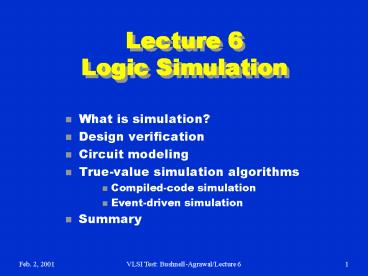Lecture 6 Logic Simulation - PowerPoint PPT Presentation
1 / 15
Title:
Lecture 6 Logic Simulation
Description:
Definition: Simulation refers to modeling of a design, its function and performance. A software simulator is a computer program; an emulator is a hardware simulator. ... – PowerPoint PPT presentation
Number of Views:98
Avg rating:3.0/5.0
Title: Lecture 6 Logic Simulation
1
Lecture 6Logic Simulation
- What is simulation?
- Design verification
- Circuit modeling
- True-value simulation algorithms
- Compiled-code simulation
- Event-driven simulation
- Summary
2
Simulation Defined
- Definition Simulation refers to modeling of a
design, its function and performance. - A software simulator is a computer program an
emulator is a hardware simulator. - Simulation is used for design verification
- Validate assumptions
- Verify logic
- Verify performance (timing)
- Types of simulation
- Logic or switch level
- Timing
- Circuit
- Fault
3
Simulation for Verification
Specification
Synthesis
Design (netlist)
Response analysis
Design changes
True-value simulation
Computed responses
Input stimuli
4
Modeling for Simulation
- Modules, blocks or components described by
- Input/output (I/O) function
- Delays associated with I/O signals
- Examples binary adder, Boolean gates, FET,
resistors and capacitors - Interconnects represent
- ideal signal carriers, or
- ideal electrical conductors
- Netlist a format (or language) that describes a
design as an interconnection of modules. Netlist
may use hierarchy.
5
Example A Full-Adder
HA inputs a, b outputs c, f AND A1, (a,
b), (c) AND A2, (d, e), (f) OR O1, (a, b),
(d) NOT N1, (c), (e)
FA inputs A, B, C outputs Carry, Sum HA
HA1, (A, B), (D, E) HA HA2, (E, C), (F,
Sum) OR O2, (D, F), (Carry)
6
Logic Model of MOS Circuit
VDD
pMOS FETs
a
Da
c
Dc
a
b
Db
c
Cc
b
Da and Db are interconnect or propagation
delays Dc is inertial delay of gate
Cb
nMOS FETs
Ca , Cb and Cc are parasitic capacitances
7
Options for Inertial Delay(simulation of a NAND
gate)
Transient region
a
Inputs
b
c (CMOS)
c (zero delay)
c (unit delay)
Logic simulation
X
rise5, fall5
c (multiple delay)
Unknown (X)
c (minmax delay)
min 2, max 5
Time units
5
0
8
Signal States
- Two-states (0, 1) can be used for purely
combinational logic with zero-delay. - Three-states (0, 1, X) are essential for timing
hazards and for sequential logic initialization. - Four-states (0, 1, X, Z) are essential for MOS
devices. See example below. - Analog signals are used for exact timing of
digital logic and for analog circuits.
Z (hold previous value)
0
0
9
Modeling Levels
Signal values 0, 1 0, 1, X and Z 0, 1 and
X Analog voltage Analog voltage, current
Modeling level Function, behavior,
RTL Logic Switch Timing Circuit
Application Architectural and
functional verification Logic verification and
test Logic verification Timing verification Di
gital timing and analog circuit verification
Timing Clock boundary Zero-delay unit-delay, mu
ltiple- delay Zero-delay Fine-grain timing Con
tinuous time
Circuit description Programming language-like
HDL Connectivity of Boolean gates, flip-flops
and transistors Transistor size and
connectivity, node capacitances Transistor
technology data, connectivity, node
capacitances Tech. Data, active/ passive
component connectivity
10
True-Value Simulation Algorithms
- Compiled-code simulation
- Applicable to zero-delay combinational logic
- Also used for cycle-accurate synchronous
sequential circuits for logic verification - Efficient for highly active circuits, but
inefficient for low-activity circuits - High-level (e.g., C language) models can be used
- Event-driven simulation
- Only gates or modules with input events are
evaluated (event means a signal change) - Delays can be accurately simulated for timing
verification - Efficient for low-activity circuits
- Can be extended for fault simulation
11
Compiled-Code Algorithm
- Step 1 Levelize combinational logic and encode
in a compilable programming language - Step 2 Initialize internal state variables
(flip-flops) - Step 3 For each input vector
- Set primary input variables
- Repeat (until steady-state or max. iterations)
- Execute compiled code
- Report or save computed variables
12
Event-Driven Algorithm(Example)
Scheduled events c 0 d 1, e 0 g
0 f 1 g 1
Activity list d, e f, g g
a 1
e 1
t 0 1 2 3 4 5 6 7 8
2
c 1 0
g 1
2
2
d 0
4
f 0
b 1
Time stack
g
8
0
4
Time, t
13
Time Wheel (Circular Stack)
max
Current time pointer
t0
Event link-list
1
2
3
4
5
6
7
14
Efficiency of Event-driven Simulator
- Simulates events (value changes) only
- Speed up over compiled-code can be ten times or
more in large logic circuits about 0.1 to 10
gates become active for an input change
Steady 0 0 to 1 event
Large logic block without activity
Steady 0 (no event)
15
Summary
- Logic or true-value simulators are essential
tools for design verification. - Verification vectors and expected responses are
generated (often manually) from specifications. - A logic simulator can be implemented using either
compiled-code or event-driven method. - Per vector complexity of a logic simulator is
approximately linear in circuit size. - Modeling level determines the evaluation
procedures used in the simulator.































